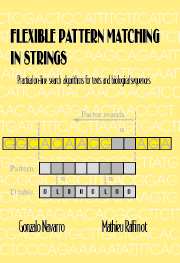 Flexible Pattern Matching in Strings
Flexible Pattern Matching in Strings 2 - String matching
Published online by Cambridge University Press: 18 December 2014
Summary
Basic concepts
The string matching problem is that of finding all the occurrences of a given pattern p = p1p2 … pm a large text T = t1t2 … tn, where both T and p are sequences of characters from a finite character set Σ. Given strings x, y, and z, we say that x is a prefix of xy, a suffix of yx, and a factor of yxz.
Many algorithms exist to solve this problem. The oldest and most famous are the Knuth-Morris-Pratt and the Boyer-Moore algorithms. These algorithms appeared in 1977. The first is worst-case linear in the size of the text. This O(n) complexity is a lower bound for the worst case of any string matching algorithm. The second is O(mn) in the worst case but is sublinear on average, that is, it may avoid reading some characters of the text. An O(nlog|Σ|m/m) lower bound on the average complexity has been proved in [Yao79].
Since 1977, many studies have been undertaken to find simpler algorithms, optimal average-case algorithms, algorithms that could also search extended patterns, constant space algorithms, and so on. There exists a large variety of research directions that have been tried, many of which lead to different string matching algorithms.
The aim of this chapter is not to present as many algorithms as possible, nor to give an exhaustive list of them. Instead, we will present the most efficient algorithms, which means the algorithms that for some pattern length and some alphabet size yield the best experimental results. Among those that have more or less the same efficiency, we will present the simplest.
The algorithms we present derive from three general search approaches, according to the way the text is searched. For all of them, a search window of the size of the pattern is slid from left to right along the text, and the pattern is searched for inside the window.
- Type
- Chapter
- Information
- Flexible Pattern Matching in StringsPractical On-Line Search Algorithms for Texts and Biological Sequences, pp. 15 - 40Publisher: Cambridge University PressPrint publication year: 2002
- 2
- Cited by


